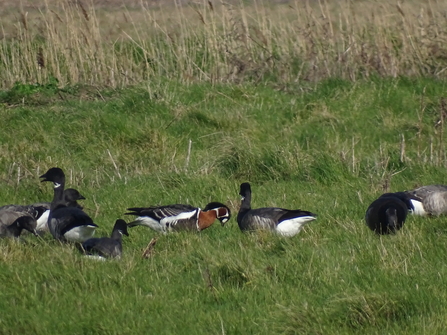The mechanical rattles and cranks of brent geese rung clear around the marsh. They mingled through the rough tussock, picking at the sward. At the first sign of danger, every bird raised its sooty head to suspiciously eye the marsh harrier gliding elegantly past. Like a Mexican wave, raised necks rippled through the flock.
Among them was a bird of vivid colour and striking patterns - a red-breasted goose with its chest the colour of copper wire, a piebald face and back neatly barred with ash-grey. Its plumage had a gold sheen in the light, illuminating its breast and fore-neck as if drizzled in golden syrup.
I waited nearly an hour for the bird to creep closer toward me until it was not 10 meters from where I was sitting on the roadside verge. It didn't care for the small group of birdwatchers standing goggle-eyed watching it. In fact, I get the impression that many Siberian birds aren’t fazed by human spectators - I once heard a Siberian chiffchaff picked an insect off a visitor's leg at RSPB Titchwell Marsh!

A red-breasted goose among a flock of brent geese at Cley (credit: Oscar Lawrence)
Every year, hundreds and thousands of geese migrate from their high-Arctic breeding grounds to spend the winter on Norfolk's marshes and coasts, and every year, a few very rare species appear among the more common swards of pink-footed and brent geese. This year, an individual red-breasted goose has been resident at NWT's very own Cley Marshes.
The bird here is a juvenile, doubtless lost among its fellow brent geese on the Arctic tundra. As young birds that have never migrated, they don't know the way like their parents do, so it is easy to get lost among other species. Two years ago, another juvenile was present at Cley Marshes, which just goes to show the importance of Cley’s habitat to wildlife, and the refuge it provides to lost vagrants.
Red-breasted geese are also prized in wildfowl collections and many have escaped to form a small breeding population in Suffolk. There is a chance, with a mix of wild and captive birds, that the species could form a substantial breeding population on our isles.
In Norfolk, any large goose flock could conceal rarities such as the redbreast or other like pale-bellied brent geese, tundra vean geese and black brent geese. Keep an eyes out next time you see large flocks of geese on sites like Holkham NNR, RSPB Buckenham Marshes or Cley – you might spot a rare Siberian gem!

